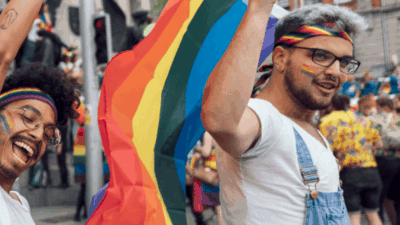
5 common misconceptions about pansexuality
This Pansexual Visibility Day, we’re exploring what it means to be pansexual, and debunking 5 common myths about pansexuality.
With our understanding of the diversity of human experience expanding – and people feeling more able to live as their true selves – it’s so important for those with more marginalised identities to be visible.
While visibility alone won’t solve everything, it can go a long way towards helping individuals understand their feelings, and to feel seen. Visibility and representation can help the mental wellbeing of LGBTQ+ people who might feel isolated, and open doors to finding community.
Sexual orientation, like all other parts of our identities, is very personal and varies from one individual to another. For me, being pansexual means that my attraction to people has no correlation with their gender.
The concept of gender doesn’t relate to the ways in which I’m attracted to others – I’m simply attracted to those with the right energy. I see beauty in someone’s entire being, just like I see beauty in nature and in the world around me. This doesn’t mean that I don’t find people physically attractive – just that this attraction doesn’t fall into categories that are related to gender. Using the term “pansexual” allows me to revel in the expansive nature of my being, and acknowledge that I form connections with people, regardless of the gendered ways in which they might be perceived by society.
Pansexuality is just another shade in the colourful spectrum of human diversity, existing in harmony alongside all the other palettes. But – as with many other terms – pansexuality has long been misunderstood.
So today, on Pansexual Visibility Day, I’m going to explore and debunk some of the common misconceptions about this beautiful segment of the LGBTQ+ community:
1. “Aren’t pansexuality and bisexuality the same thing?”
While there are many overlaps between pansexuality and bisexuality, the official definitions differ in their approach to gender. The prefix pan- means “all”, so pansexuality is an attraction to all gender identities or attraction regardless of gender identity, while bisexuality is the attraction to multiple gender identities.
There may be individuals who align with the way pansexuality is defined yet identify with the term ‘bisexuality’, and that’s completely valid. Others may use pansexual and bisexual interchangeably. Our identities are personal and specific to each and every one of us – that’s what makes us all unique!
2. “I’ve heard that pansexuality is transphobic.”
One of the biggest misconceptions about pansexuality is that pansexual people are somehow being transphobic by stating that they’re attracted to trans people while bisexual people aren’t, because they don’t see trans people as men or women. This is a dangerous and untrue myth! Pansexuality is attraction regardless of gender, so a pansexual person’s attraction to someone has nothing to do with whether they are trans or cis.
Similarly, the existence of pansexuality does not mean that bisexual people are only attracted to men or women. Bisexual people can be attracted to people with the same gender identity, and with different gender identities from their own – including non-binary people. The recently emerging term “bi+” now makes it even more explicit that bisexuality isn’t limited by binary definitions of gender and sexuality!
3. “How can someone be attracted to everyone? Pansexuals are just greedy!”
Just because someone has the potential to be attracted to anyone doesn’t mean they are any more or less likely to be attracted to an individual. And it especially doesn’t mean that they’re automatically attracted to everyone. This is a myth that mirrors the homophobic notion that all gay men or lesbians are automatically attracted to every man or woman they meet.
It isn’t “greedy” for someone to have the potential to be attracted to people of all genders. Someone identifying as pansexual doesn’t mean they are constantly pursuing others, are more likely to cheat, or are incapable of committing to relationships. How adults decide to build consensual relationships is nobody else’s business!
4. “Pansexual people are confused – they can’t make up their mind about what they want.”
Like bisexuality, pansexuality is often erased and labelled as “sitting on the fence” or a “stepping-stone to being gay”. This misconception is commonly presented in a gendered way, with women labelled as “straight but experimenting”, and men assumed to be “gay, but too scared to fully come out”. Aside from being inherently queerphobic, these ideas are just another way in which the patriarchy manifests within our social culture.
When we make the above gendered assumptions, we’re centring men in our understanding of sexuality. We’re suggesting that it’s not possible for an individual to be attracted to people with multiple gender identities without their primary attraction being towards men. This just isn’t true: pansexual people know who they are, and they don’t need to pick between people of different genders to prove it.
5. “Pansexuality is just a new fad!”
The term pansexual is, in fact, not a new term. The word has been included in the Oxford English Dictionary since at least the early 1900s, and has been used in its current definition since at least the late 1960s. While LGBTQ+ people have long been using a range of different terms to describe their identities, we’re simply more aware of them now due to increasing social acceptance, as well as access to diverse experiences through the internet and social media.
Even if it was a new term, however, this would not invalidate pansexual people’s experiences, or suggest that they were being inauthentic. As public perception progresses, it’s likely that our language will expand and evolve to include the vast diversity of human experience – and that’s beautiful!


